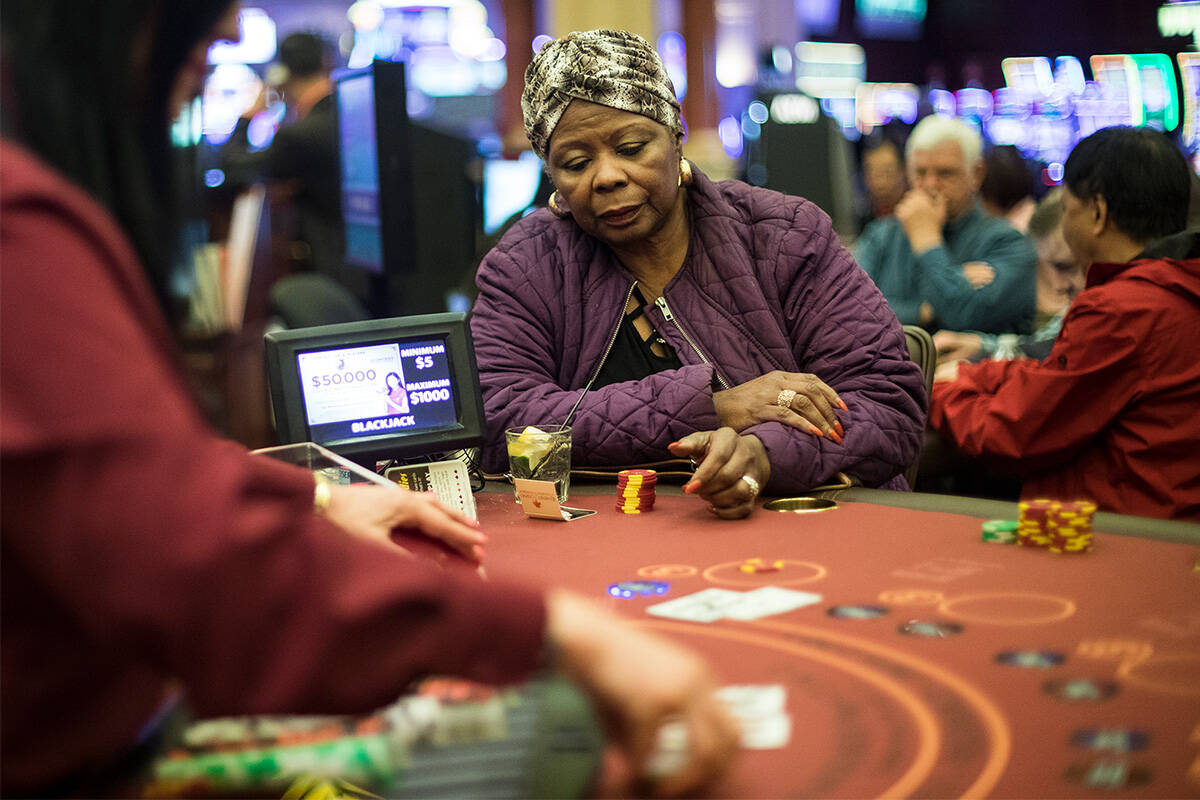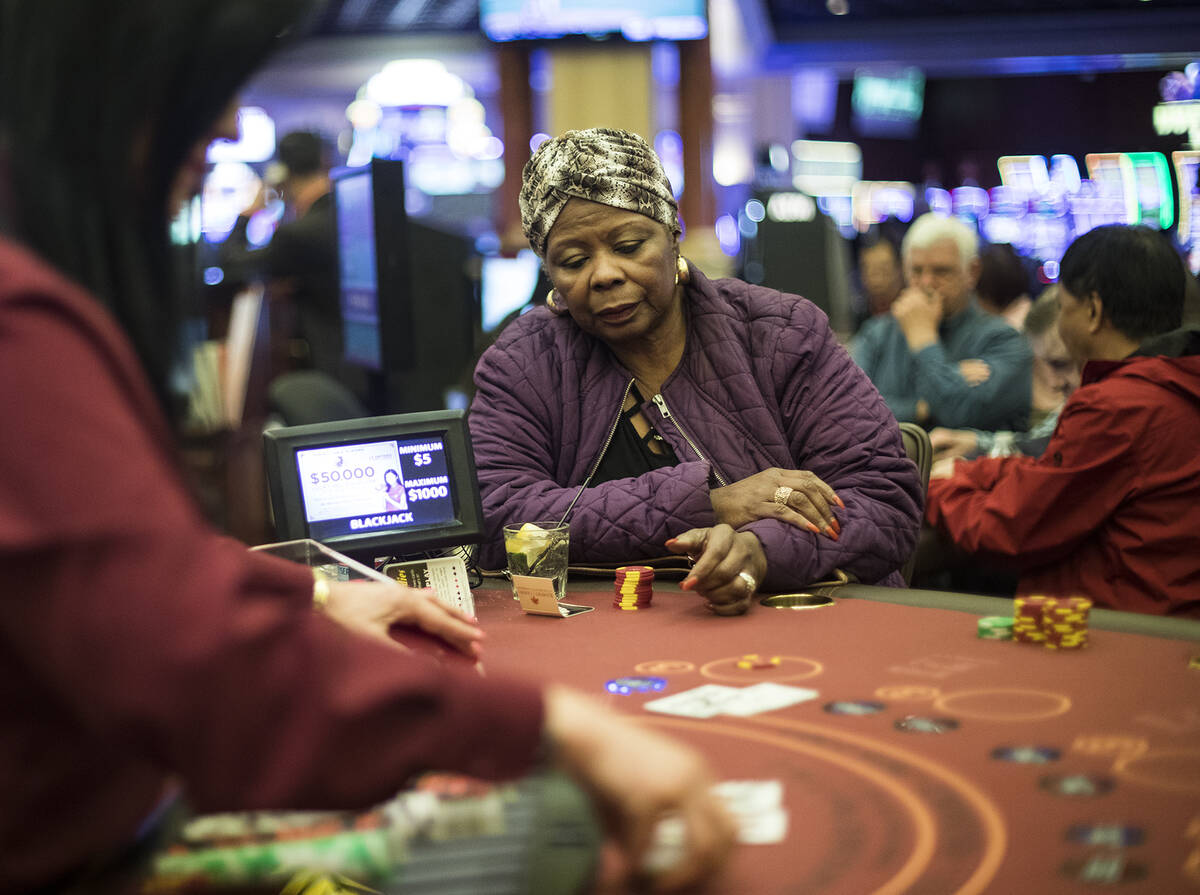It’s easy and fun to play casinos’ most popular table game
It’s the most popular table game in Nevada casinos and one of the games that gives the player the best chance of winning.
Blackjack. Or, as some in the industry call it, Twenty-One.
Not only is it popular, with close to half of the nearly 5,000 table units in the state playing the game, but it generally gives players a good chance of winning because they control some of the variables that determine the game’s outcome.
The Nevada Gaming Control Board says in general, casinos have between an 11 and 15 percent hold on all money wagered on blackjack. In 2023, that was around $1.3 billion kept by casinos on $8.9 billion wagered. And, in 2023, 2,723 games of the 6,230 tables in the state were for blackjack, broadly surpassing the next closest, 460 roulette wheels and 319 craps tables.
First believed to be played in the late 1700s, the game is easy to learn, fun to play and requires very basic adding skills.
Generally played at a table by up to nine players in a semicircle with a dealer in the center using a standard 52-card deck, a game begins with each player placing a bet and receiving two cards face up with the dealer getting one card face up and the other, face down (the hole card). In most casinos, blackjack is played with multiple decks of cards in a shoe and the more decks that are used, the higher the house advantage becomes.
Aces worth 1 or 11
Each dealt card is assigned a face value, with 10s, jacks, queens and kings having a value of 10 and aces having a value of either one or 11, depending on what is most advantageous to the player.
The object is to reach 21 without going over that total.
Players receiving an ace and a 10 card in the initial deal hit a natural blackjack and are paid immediately unless the dealer has an ace showing in its hand or it has a natural blackjack.
Otherwise, play continues in a clockwise direction with each player either hitting — adding a card — or standing, reaching a total of 21 or less.
Once every player has ended their turn by standing on their amounts or “busting,” by going over 21, the dealer reconciles its own hand, drawing until it reaches 17 to 21. Depending on house rules, a dealer can either hit or stand on a “soft 17,” when the total reaches 17 with an ace in play. If the dealer busts after the draw, every player who still has cards in the game wins. Otherwise, players with more than the dealer win, those with less than the dealer lose and those with exactly the same total “push” and no money is won or lost.
Players have other options after the initial deal. They can double down on a 10 or 11, doubling their wager and agreeing to take just one card. Or, if they have two cards that are the same, they can split them by doubling the wager and playing each one like a new hand, each trying to reach 21.
Using strategy
Skilled blackjack players generally use traditional blackjack strategy when they play, knowing whether to hit or stand based on the face value of the dealer’s hand that’s showing.
For example, if the dealer is showing a 10, a player generally is more cautious, believing the hole card may be another 10 or an ace that could land the dealer on 20 or 21. But if it’s a 6 and the hole card is a 10, the dealer could have 16 and would have to be hit, possibly busting.
Players who know traditional blackjack strategy usually memorize the different scenarios of whether to hit or stand on every possible hand.
Betting on blackjack is also simple.
Winners are generally paid even money for a win. If a player bets $15, a common table minimum in most casinos, and they win, they receive $15. When they lose, they surrender the entire wager.
The payment for winning with a natural blackjack can be different depending on where you play. Most casinos with multiple-deck games in play pay 6:5 on blackjacks, that is receiving $6 for every $5 wagered. A $15 bet on a hand that is a natural blackjack pays the player $33 — the $15 wager itself and the 6:5 payout of $18.
Those pesky 6:5 payouts
The 6:5 payout is a source of irritation to most blackjack players because historically, casinos have paid 3:2 on winning hands, a $3 payout for every $2 bet.
On the same $15 wager at a table offering 3:2 payouts, the player would receive $37.50 – the $15 wager itself and the 3:2 payout of $22.50.
While a $4.50 difference isn’t much, 6:5 payouts can be much less when, say, $1,000 is bet on one hand — $1,500 vs. $1,200.
Gambling activists have called attention to the disparity between 3:2 and 6:5 payouts every March 2, or 3/2 on the calendar.
A common blackjack side bet in some games is for “insurance,” a wager offered when a dealer is showing an ace after the initial deal. Players then make a bet as to whether or not the dealer has a natural blackjack. An insurance wager costs half the player’s wager, but it pays off 2-to-1 if the dealer has a blackjack.
Contact Richard N. Velotta at rvelotta@reviewjournal.com or 702-477-3893. Follow @RickVelotta on X.



















